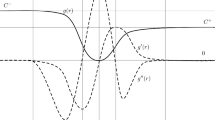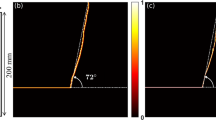Abstract
A mechanical model is introduced for predicting the initiation and evolution of complex fracture patterns without the need for a damage variable or law. The model, a continuum variant of Newton’s second law, uses integral rather than partial differential operators where the region of integration is over finite domain. The force interaction is derived from a novel nonconvex strain energy density function, resulting in a nonmonotonic material model. The resulting equation of motion is proved to be mathematically well-posed. The model has the capacity to simulate nucleation and growth of multiple, mutually interacting dynamic fractures. In the limit of zero region of integration, the model reproduces the classic Griffith model of brittle fracture. The simplicity of the formulation avoids the need for supplemental kinetic relations that dictate crack growth or the need for an explicit damage evolution law.







Similar content being viewed by others
Notes
This can be thought of as the “number of bonds” strained past the threshold divided by the total “number of bonds” connected to x.
References
Ambrosio L, Coscia A, Dal Maso G (1997) Fine properties of functions with bounded deformation. Arch Ration Mech Anal 139:201–238
Bourdin B, Larsen C, Richardson C (2011) A time-discrete model for dynamic fracture based on crack regularization. Int J Fract 168:133–143
Borden M, Verhoosel C, Scott M, Hughes T, Landis C (2012) A phase-field description of dynamic brittle fracture. Comput Methods Appl Mech Eng 217:77–95
Duarte CA, Hamzeh ON, Liszka TJ, Tworzydlo WW (2001) A generalized finite element method for the simulation of three-dimensional dynamic crack propagation. Comput Methods Appl Mech Eng 190:2227–2262
Elices M, Guinea GV, Gómez J, Planas J (2002) The cohesive zone model: advantages, limitations, and challenges. Eng Fract Mech 69:137–163
Emmrich E, Weckner O (2007) On the well-posedness of the linear peridynamic model and its convergence towards the Navier equation of linear elasticity. Commun Math Sci 4:851– 864
Fineberg J, Marder M (1999) Instability in dynamic fracture. Phys Rep 313:1–108
Foster JT, Silling SA, Chen W (2011) An energy based failure criterion for use with peridynamic states. J Multiscale Comput Eng 9:675–687
Jha PK, Lipton R (2018) Numerical analysis of nonlocal fracture models in Hölder space. SIAM J Numer Anal 56:906–941
Jha PK, Lipton R (2018) Finite element approximation of nonlocal fracture models. arXiv:1710.07661
Jha PK, Lipton R (2019) Numerical convergence of finite difference approximations for state based peridynamic fracture models. arXiv:1805.00296 To appear in Computer Methods in Applied Mechanics and Engineering
Ha YD, Bobaru F (2010) Studies of dynamic crack propagation and crack branching with peridynamics. Int J Fract 162:229–244
Hu W, Ha YD, Bobaru F, Silling SA (2012) The formulation and computation of the nonlocal J-integral in bond-based peridynamics. Int J Fract 176:195–206
Larsen CJ, Ortner C, Suli E (2010) Existence of solutions to a regularized model of dynamic fracture. Math Models Methods Appl Sci 20:1021–1048
Lehoucq RB, Sears MP (2011) The statistical mechanical foundation of the peridynamic nonlocal continuum theory: energy and momentum conservation laws. Phys Rev E 84:031112
Lipton R (2014) Dynamic brittle fracture as a small horizon limit of peridynamics. J Elast 117:21–50
Lipton R (2016) Cohesive dynamics and brittle fracture. J Elast 124:143–191
Lipton R, Said E, Jha PK (2018) Dynamic brittle fracture from nonlocal double-well potentials: a state based model. In: Voyiadjis G (ed) Handbook of Nonlocal Continuum Mechanics for Materials and Structures, pp 1265–1291
Mengesha T, Du Q (2014) Nonlocal constrained value problems for a linear peridynamic Navier equation. J Elast 116:27–51
Miehe C, Hofacker M, Welschinger F (2010) A phase field model for rate-independent crack propagation Robust algorithmic implementation based on operator splits. Comput Methods Appl Mech Eng 199:2765–2778
Moës NM, Belytschko T (2002) Extended finite element method for cohesive crack growth. Eng Fract Mech 69:813– 833
Silling SA, Askari E (2005) A meshfree method based on the peridynamic model of solid mechanics. Comput Struct 83:1526–1535
Silling SA, Lehoucq RB (2008) Convergence of peridynamics to classical elasticity theory. J Elast 93:13–37
Silling SA, Lehoucq RB (2010) Peridynamic theory of solid mechanics. Adv Appl Mech 44:73–166
Silling SA, Weckner O, Askari E, Bobaru F (2010) Crack nucleation in a peridynamic solid. Int J Fract 162:219–227
Pustejovsky MA (1979) Fatigue crack propagation in titanium under general in-plane loading—I: experiments. Eng Fract Mech 11:9–15
Ayatollahi MR, Aliha MRM (2009) Analysis of a new specimen for mixed mode fracture tests on brittle materials. Eng Fract Mech 76:1563–1573
Madenci E, Dorduncu M, Barut A, Phan N (2018) A state-based peridynamic analysis in a finite element framework. Eng Fract Mech 195:104–128
Acknowledgements
The authors would like to express their gratitude to Stewart Silling for sharing his perspectives, and his generous scientific input. This material is based upon work supported by the U.S. Army Research Laboratory and the U.S. Army Research Office under grant number W911NF1610456 (RPL and PKJ). We acknowledge the support of Sandia National Laboratories. Sandia National Laboratories is a multimission laboratory managed and operated by National Technology & Engineering Solutions of Sandia LLC, a wholly owned subsidiary of Honeywell International Inc. for the U.S. Department of Energy’s National Nuclear Security Administration under contract DE-NA0003525.
Author information
Authors and Affiliations
Corresponding author
Rights and permissions
About this article
Cite this article
Lipton, R.P., Lehoucq, R.B. & Jha, P.K. Complex Fracture Nucleation and Evolution with Nonlocal Elastodynamics. J Peridyn Nonlocal Model 1, 122–130 (2019). https://doi.org/10.1007/s42102-019-00010-0
Received:
Accepted:
Published:
Issue Date:
DOI: https://doi.org/10.1007/s42102-019-00010-0




